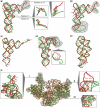ModeRNA: a tool for comparative modeling of RNA 3D structure
- PMID: 21300639
- PMCID: PMC3105415
- DOI: 10.1093/nar/gkq1320
ModeRNA: a tool for comparative modeling of RNA 3D structure
Abstract
RNA is a large group of functionally important biomacromolecules. In striking analogy to proteins, the function of RNA depends on its structure and dynamics, which in turn is encoded in the linear sequence. However, while there are numerous methods for computational prediction of protein three-dimensional (3D) structure from sequence, with comparative modeling being the most reliable approach, there are very few such methods for RNA. Here, we present ModeRNA, a software tool for comparative modeling of RNA 3D structures. As an input, ModeRNA requires a 3D structure of a template RNA molecule, and a sequence alignment between the target to be modeled and the template. It must be emphasized that a good alignment is required for successful modeling, and for large and complex RNA molecules the development of a good alignment usually requires manual adjustments of the input data based on previous expertise of the respective RNA family. ModeRNA can model post-transcriptional modifications, a functionally important feature analogous to post-translational modifications in proteins. ModeRNA can also model DNA structures or use them as templates. It is equipped with many functions for merging fragments of different nucleic acid structures into a single model and analyzing their geometry. Windows and UNIX implementations of ModeRNA with comprehensive documentation and a tutorial are freely available.
Figures





Similar articles
-
RNA 3D Structure Modeling by Combination of Template-Based Method ModeRNA, Template-Free Folding with SimRNA, and Refinement with QRNAS.Methods Mol Biol. 2016;1490:217-35. doi: 10.1007/978-1-4939-6433-8_14. Methods Mol Biol. 2016. PMID: 27665602
-
ModeRNA server: an online tool for modeling RNA 3D structures.Bioinformatics. 2011 Sep 1;27(17):2441-2. doi: 10.1093/bioinformatics/btr400. Epub 2011 Jul 4. Bioinformatics. 2011. PMID: 21727140
-
RNA tertiary structure prediction with ModeRNA.Brief Bioinform. 2011 Nov;12(6):601-13. doi: 10.1093/bib/bbr050. Epub 2011 Sep 6. Brief Bioinform. 2011. PMID: 21896613
-
Automated modeling of RNA 3D structure.Methods Mol Biol. 2014;1097:395-415. doi: 10.1007/978-1-62703-709-9_18. Methods Mol Biol. 2014. PMID: 24639169 Review.
-
RNA and protein 3D structure modeling: similarities and differences.J Mol Model. 2011 Sep;17(9):2325-36. doi: 10.1007/s00894-010-0951-x. Epub 2011 Jan 22. J Mol Model. 2011. PMID: 21258831 Free PMC article. Review.
Cited by
-
MetalionRNA: computational predictor of metal-binding sites in RNA structures.Bioinformatics. 2012 Jan 15;28(2):198-205. doi: 10.1093/bioinformatics/btr636. Epub 2011 Nov 21. Bioinformatics. 2012. PMID: 22110243 Free PMC article.
-
Crystallographic and Computational Analyses of AUUCU Repeating RNA That Causes Spinocerebellar Ataxia Type 10 (SCA10).Biochemistry. 2015 Jun 23;54(24):3851-9. doi: 10.1021/acs.biochem.5b00551. Epub 2015 Jun 12. Biochemistry. 2015. PMID: 26039897 Free PMC article.
-
T-psi-C: user friendly database of tRNA sequences and structures.Nucleic Acids Res. 2020 Jan 8;48(D1):D256-D260. doi: 10.1093/nar/gkz922. Nucleic Acids Res. 2020. PMID: 31624839 Free PMC article.
-
Sequence-sensitive elastic network captures dynamical features necessary for miR-125a maturation.PLoS Comput Biol. 2022 Dec 14;18(12):e1010777. doi: 10.1371/journal.pcbi.1010777. eCollection 2022 Dec. PLoS Comput Biol. 2022. PMID: 36516216 Free PMC article.
-
Structure of the translating Neurospora ribosome arrested by cycloheximide.Proc Natl Acad Sci U S A. 2021 Nov 30;118(48):e2111862118. doi: 10.1073/pnas.2111862118. Proc Natl Acad Sci U S A. 2021. PMID: 34815343 Free PMC article.
References
-
- Gesteland RF, Cech TR, Atkins JF. The RNA World. 3 edn. Cold Spring Harbor, New York: Cold Spring Harbor Laboratory Press; 2005.
-
- Berman HM, Westbrook J, Feng Z, Iype L, Schneider B, Zardecki C. The Nucleic Acid Database. Acta Crystallogr. D Biol. Crystallogr. 2002;58:889–898. - PubMed
-
- Moult J. A decade of CASP: progress, bottlenecks and prognosis in protein structure prediction. Curr. Opin. Struct. Biol. 2005;15:285–289. - PubMed
Publication types
MeSH terms
Substances
LinkOut - more resources
Full Text Sources
Research Materials

